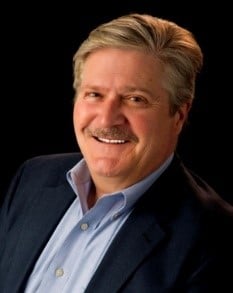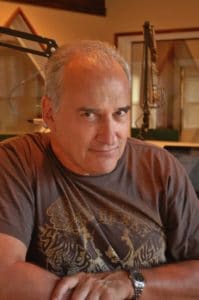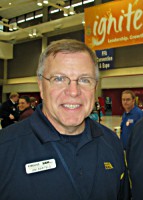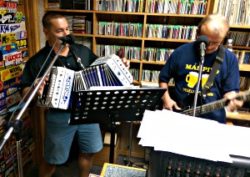
(By Jon Quick) There’s a pretty well-known American out there who would attribute a lot of his early success in politics to doing an Indianapolis-based radio talk show that was once networked to a couple of dozen small cities and towns in the Hoosier State. He would tell you that it was through radio that he began to become one of the most well-known figures in the state. When he was first elected to Congress in 2001, this man who once called me his program director never forgot his radio roots.
He remembered those real, hard-working people — farmers, bankers, factory workers, moms and working moms — who got him elected. Realizing the importance of staying in touch with them, he was the first U.S. representative to install radio equipment in his Washington, DC office to make himself available on a regular basis to stations across Indiana. Politics aside, he knew how to use the power of radio to his advantage. It later helped elect him governor of Indiana.
Recently, we’ve heard that Mike Pence has moved back to Washington. Some might be less than happy about that, but let’s set those opinions aside for now.
One of the great powers of radio is still its ability to be more locally focused than any other medium. Many would also agree that the more radio becomes just another music box with nondescript announcers and the lack of any differentiation, the more radio’s relevance will fade. Others might say that’s already happening.
If you don’t agree, feel free to turn to another page. But if you have some concerns about the state of the radio industry, stay with me.
So where has real radio gone? Many of my colleagues contend that the place where you hear it most is in the smaller markets. These operators just don’t get enough credit. Let’s change that. In fact, a momentous change has already been made. With the advent of digital media, conceptually there really are no market sizes anymore. Anyone can hear most any radio station anywhere in the world, including those small markets where the unique medium radio once was still lives.
Those of us who are real radio geeks find immense joy while driving across America listening to these local radio treasures. They are still on the AM and FM bands, but also streaming on a variety of new platforms.
Of course, we called upon the beloved radio historian and holder of the title “Radio’s Best Friend.” Art Vuolo quickly responded, “Smallmarket radio is where the fun is, where the caring people are, and where the key elements of radio serving a community still exist.” Art adds, “In a business not known for its stability, you can find 20-, 30-, and even 40-year veterans in places like New Ulm, MN; Saginaw, MI; and Athens, OH. That’s hard to find at big corporate stations in major markets today.”
This doesn’t at all mean these talents aren’t good enough to work in a bigger market. Most of these dedicated personalities just love small-market radio, where they can still have fun every day, not worry about the price of the company stock, and be allowed to be creative without tight clocks and so many time restraints. In fact, more and more major-market greats are going back to their small-market roots for just that reason.
With credit to the many great radio stations and personalities in many of those bigger markets, you still hear people saying, “Whatever happened to radio?” James Edward “Jed” Duvall of WFYI in Indianapolis reminded me of a jingle done back in the early ’70s, way before people had the serious concerns about radio they have today.
That jingle went something like this: “It’s a shame what’s happened to radio, but they can’t afford to do it anymore. It’s a shame they can’t hire a section of strings and a group that sings ‘W-I-B-C’ (or ‘K-V-I-L’) … but they can’t afford to do it anymore (do it anymore).”
Maybe it’s time we brought back that jingle.
We can find great radio in a lot of places. But for now, let’s focus on the Midwest, known as the Heartland of America. (It’s also referred to as “flyover country” by people who don’t know any better.) Let’s hop around and visit a few of these stations. We’ll find some notable examples of real radio — stations entertaining, informing, and taking care of their communities.
First stop: WEFM 95.9 in Michigan City, IN. Today’s it’s the home of one of America’s legendary radio personalities and the author of Records Truly Is My Middle Name, John Records Landecker. Soon to be honored this fall after being elected into the National Radio Hall of Fame on the first ballot, Landecker says, with no qualms at all, “There are few people in this industry today who really know how to make radio work, from creating informative and entertaining programming to creating advertising that really works, despite the ratings.”

Landecker adds (just slightly tongue-incheek), “And it’s not accumulating $20 billion in debt! I still love doing radio because of my love and enthusiasm for radio. I know that’s why I got into the business.”
Today you can hear Landecker (on-air or online) doing a weekly radio program in Michigan City. You might also be lucky enough hear him doing an occasional high school football or basketball game or a town parade. “It’s the most fun I’ve had in radio in a long time,” he says. “There are no ratings here. Just people that really get it. But hey, gotta sign off now. Going to do a remote at the local Honda dealer. (I’m not kidding.)”
I remember standing-room-only at a radio conference some years ago, when the speaker was radio wizard Randy Michaels. He said about those who think a successful radio product is all about ratings, especially for the News/ Talk format: “Selling cost per point misses the point. Instead, the real sellers today can sell beyond the book. They know how to sell radio’s impact factor.”
The small markets have learned to do that. Many of them are in unrated markets, yet they still find ways to sell both the on-air and the online product. Plus, they are masters at selling events that add substantially to the bottom line.
Scenic southern Minnesota is where you’ll find three-time Marconi finalist KNUJ in New Ulm, a small town of just over 13,000 people at the confluence of the Minnesota and the Cottonwood Rivers. (New Ulm is home to Schell’s Beer.) One of many small stations owned by Tor Ingstad of the famed Ingstad family of broadcasters, KNUJ is as progressive as any station in the larger markets.

General Manager Jim Bartels says, “We don’t use ratings. We sell Main Street, not Wall Street. We sell the power of real hometown radio. We sell results, and do it by developing solid relationships with our clients and community of listeners. It takes work, but it’s radio the way radio was always meant to be. I think the big boys from the large metros would really enjoy watching us operate. They might learn something — and we might learn from them. It’s time radio people from all markets started working together to make radio stronger than ever.”
And, by the way, the Tor Ingstad-owned stations have embraced digital and social media as well as any, and realize there’s a whole new world of revenue out there.

Another Minnesota small-market station, this one 45 miles southwest of the Twin Cities, is KCHK in New Prague. A daily polka hour is still alive and well, and the station still features live music in studio on the popular Live Musician Friday.
Just about another hour down the road, we can tune in to KNUJ/Hutchinson, MN. Another part of the down-home charm found in the small markets are those cherished real-life local characters that you just cannot invent — naturally funny personalities who speak the language of their listeners. Perhaps the most famous was Wally Pikal, who for decades did a Friday radio show called The Pikal Patch on KDUZ/Hutchinson, entertaining audiences with his old-time band.
A true character, Wally played two and even three trumpets at the same time, sometimes doing so while jumping on a pogo stick, to the amazement of his audiences. In an appearance on The Tonight Show (guest host Joey Bishop was filling in for Johnny Carson) in 1973, Wally played three trumpets while jumping on his pogo stick, to which Bishop responded, “Son of a gun!” Wally continued to perform almost until he passed away, just this past March. His death brought emotional tributes in media outlets big and small throughout the area.
Meanwhile, if we jump way up north to the portion of Minnesota known as “God’s Country,” we find KTRF-AM/Thief River Falls. “A radio station like KTRF-AM is as important to a community as the hospital, police station, and fire department,” says GM Jake Weber. “Over the past 70 years, broadcasting technology advancements have greatly improved the tools we use to serve our listeners and clients in Thief River Falls. However, a voice coming over the radio in the middle of a storm will always be our greatest strength. If you want to truly feel alive and see the power of radio firsthand, go to work for a small-market station. I’ve worked in bigger markets, but I came back.”
Continuing our journey, just two hours to the south, on the border between North Dakota and Minnesota, the AM giant known as “The Mighty 790,” KFGO, still stands tall. This Duke Wright-owned radio station is one of the true examples of radio greatness. Twice the winner of the Marconi for News/Talk Station of the Year against some of the most distinguished major market stations in the U.S., and booming across vast stretches of Minnesota, the Dakotas, and north into Canada, KFGO prides itself in being all-local 24/7, with a news unit and personalities that rival any in the country. The station has also won two Peabody Awards, one of them for what law enforcement and major political figures called “life-saving public service” during coverage of major flooding that crippled the region — as KFGO stayed on the air while other media found it difficult to operate during power outages.
Dakota and Minnesota, the AM giant known as “The Mighty 790,” KFGO, still stands tall. This Duke Wright-owned radio station is one of the true examples of radio greatness. Twice the winner of the Marconi for News/Talk Station of the Year against some of the most distinguished major market stations in the U.S., and booming across vast stretches of Minnesota, the Dakotas, and north into Canada, KFGO prides itself in being all-local 24/7, with a news unit and personalities that rival any in the country. The station has also won two Peabody Awards, one of them for what law enforcement and major political figures called “life-saving public service” during coverage of major flooding that crippled the region — as KFGO stayed on the air while other media found it difficult to operate during power outages.
“What’s old is new,” says KFGO GM Dan Cash. “Local radio has so much going for it. We are the original Facebook Live. We are the original mobile medium. We created geofencing through live broadcasts, yard signs, and banners. Our success will be defined by our ability to recognize that we did these things first. It’s time to re-educate the masses on just how powerful live radio, nontraditional-revenue-producing events, jingles, and local production really are.
Taking a quick flight down to southwest Indiana, the owner of DLC Media, Dave Crooks, says, “Radio is in my blood so thick that I chose to give up my second love — politics — in exchange for creating a mini-empire of nine radio stations in small towns that include Brazil, Washington, Terre Haute, and Rockville, IN.” The six-term Indiana member of the Indiana House and onetime U.S. congressional hopeful today faithfully sets his clock radio at 5:58 to catch CBS News at the top of the hour — then travels each morning to the White Steamer restaurant to catch up on the rest of the news.
“My staff appreciates that I am in the trenches with them,” Crooks says. “I don’t ask them to do things I wouldn’t do myself.” Crooks believes he has the formula for building a good local radio station: “You’ve got to do a respectable job of covering the local communities and putting the local high school basketball games on the air.”
He also stresses the importance of an exceptional news product and weather coverage strong enough to be life-saving when needed. Recently, Crooks even brought in significant revenue by doing play-by-play of the Indiana All-Star State Little League Championship. The idea started when one of his morning announcers, DeWayne Shake, told Crooks his 14-yearold son made the All-Star Team. He obviously takes an interest in his employees’ lives and shares their joys and sorrows.
“Despite all the new digital options consumers now have and which we use extensively, I still believe traditional media remains strong,” says. “People still want to read their local newspaper and listen to local radio stations. If you keep the content local and take good care of the communities you serve, there is still a path to success.”
These small-town stations have several in common. First, it’s local programming that touches the community in a variety of ways. Also, from a sales standpoint, they know how to sell based on relationships. They don’t have ratings, nor do they need them because they have mastered the art of real salesmanship.
Radio is also still especially viable in so many of these small markets because they often don’t have a daily local newspaper. Local radio fills the bill with daily listings of birthdays and anniversaries, school lunch menus, births and death notices. Even swap shop and “Tradio” shows are still popular and add to the charm.
One of radio’s greatest visionaries, Emmis Communications CEO Jeff Smulyan, says, “Anyone who knows me knows that I am a huge fan of radio in any size market. Yet it occurs to me sometimes that some companies have forgotten the dedication to the great live and local personalities — people who touch their communities with relevant content that is entertaining, informative, and sometimes life-saving in the case of natural disasters and severe weather coverage. That’s where local radio shines. I especially applaud the smaller markets for their performance in these areas. We can learn a lot from them.
“At Emmis, we are working hard to keep local radio alive and well. We are very proud of the progress we have made with NextRadio, designed, in part, to keep real local radio alive and well. Today we carry smartphones like we once did transistor radios. To have radio easily available on our phones is a natural, both to provide easier access to local stations for entertainment, but also for vital news and information that is sometimes only available on radio.”
Despite the naysayers, NextRadio will be a home run in helping local radio survive, if Smulyan, his team, and the NAB have anything to say about it.
Back around 1990, I cut out a piece I found in the radio trades, and I keep it in my top drawer to this day. It’s from one of America’s all-time great programmers, the late Rick Sklar, the man who made WABC one of the greatest success stories in radio. It’s as valid today as it was then – maybe even more so.
“Programming and marketing decisions in radio today are driven by numbers, statistics, and computer-interpreted data, often at the expense of plain common sense and showmanship. People are afraid to be creative unless it’s been researched. But the longer I’m in radio, the more obvious it becomes to me that we’re in show business. The giant stations that dominate their markets year after year, like the long-running hits on Broadway and the top ten movies, songs and books of the year, entertain with a capital ‘E.’ Stations that don’t creatively entertain, first and foremost, are doomed to mechanical mediocrity in their sound and their rating performance.”
If you’re one of those who sometimes wonders “Where has all the great radio gone?” take some time to check out some of the too-often unheralded small-market stations, personalities, and operators. As more of the big companies face fiscal crises and their stations become more and more generic, the day may come where real radio is gone and the industry must reinvent itself. Let’s hope not. But if so, maybe a good start would be a trip to New Ulm, MN; Washington, IN; or Fargo, ND.

Jon Quick is a veteran manager of over 25 years for CBS/Minneapolis and Emmis/Indianapolis. Today he consults radio stations, with a specialty in small markets. He is also the president and owner of a full-service ad agency, Q Public Relations & Marketing, headquartered in Indianapolis. He can be reached at 317.432.0309 or [email protected].






Jon, great piece! Thank you for writing it. I would add that the folks who work in small markets are usually very involved citizens in their communities. Not only are they superstars on the radio but they are also a big part of the public service and economic development in the communities they work in. I am the Affiliate Relations Director for a 50 station radio network in my state. I travel and visit a small town radio station once a week. The one thing that stands out to me is how involved in community the successful stations are. (Not just public service spots but hands on volunteering, serving on school boards, civic clubs, chamber of commerce, supporting the high school football team, etc.) Great citizens of their towns…who give back personally and through the marketing strength of radio.
Bob — Thanks so much for the kind reply. It’s obvious you get it! So appreciate your response!
Thanks John. Well done!!!
Walter — I have had such tremendous response to this piece that Ed Ryan asked me to write. Really gratifying. Most of all, getting such a comment from a man of your stature in this business is truly a thrill. Always the best, Walter. Jon
Great story. I want to give a shout out to the morning man on my radio stations (WBRV-FM/WLLG-FM) in Boonville and Lowville, NY. George Capron will be celebrating 54 years of LIVE broadcasting on our stations(he’s been with us since he was 19) ! He is an institution in our small market and we are proud to be LIVE and LOCAL!
WOW! Thanks Bill and kudos to George! You’re doing radio right!! Best always, Jon
It’s a great article about small market radio. This is what radio should be, but big companies worried about ratings and debt hire consultants and program directors that create a format that’s used on dozens of stations. Each market is different and deserves to be treated as such. It’s best left to the people who have lived and worked there for years. I’ve been the morning host at KKWS-FM in Wadena, MN for 33 years. Who do you think knows the market best? I’m lucky Hubbard Broadcasting allows me to be as creative as I want to be. That’s real radio. And if you don’t believe that, ask yourself what the greatest radio stations you’ve ever heard have in common…one thing…the people who work on the air.
Mike — Thanks for the great and kind words. You work for one company that really gets it. So glad you realize that it’s localism and great personalities that still make radio work. Best always, Jon
QPRMarketing.com
Mr. Quick:
The last time I heard the station in Washington, Indiana it was broadcasting one of the rather bland Westwood One voice-tracked 24 hour satellite programming services. Exactly, what are we to learn from that small market treasure? B.B.B.
Most successful Radio and TV Stations utilize Networks. I don’t see a problem with such decisions. If you would listen to WAMW-FM for more than a few minutes you’ll discover we don’t ride the Network 24-7. Even when we do re-broadcast the Network, we do a great job localizing the content. WAMW-FM has over 40 hours a week in local and original programming including a top-notch Morning Show and Afternoon Show. We produce these shows 6 days a week. We utilize CBS Radio News 24/7. Our local News features two daily news reporters from the Community. We also attend and cover around 10 meetings a month and use a lot of audio during our news. Daily guests are in-studio for “Take 5 for your Community.” We originate around 150 sporting events per year including High School Sports to tournament Little League games. We use Comrex Access units so all our broadcasts sound great! We also sell around 2-3 remotes per week. If something is going on in our community, WAMW is usually there. When severe weather is predicted, my Ops Mgr is only a few blocks away and we localize our coverage no matter the time of day. I’m not going to apologize for utilizing Network services to complete our 24 hour programming. If you actually lived in our market and talked to our local residents you would be the only person labeling our station “bland”. I applaud all Small-Market Broadcasters who utilize the latest technology to make their radio stations sound live and local. The key to success is what you do between the songs.
John
Great read on small market radio. I remember growing up in Brookville, Indiana near Cincinnati listening to John “Records” Landecker on WLS in Chicago and of course Superjock Larry Lujack and others. These men shaped a young man’s future and brought out the radio fever in my. I have been at WITZ FM in Jasper, IN for almost 41 years starting out as a night jock, PD, OM, and now GM of 4 stations including our Hispanic programmed WITZ AM 990 Radio Juan. Dave Crooks is a good friend and like Dave we still are full service radio stations that serve our local community and don’t sell by the numbers. Ratings aren’t important. Results for our clients are. If you’d like to continue this small market radio piece I’d love for us to talk more. I have a great story to tell along the same lines as what you’ve written here.
Gene — Thanks for the really nice work! Dave Crooks is one of those great operators who really knows how to relate to his local audience through his stations and related platforms. Landecker is a close friend and he really has no idea how many thousands of young people that he influenced to get into radio. Little wonder, he’ll be inducted into the Radio Hall of Fame in early November. Yes, I will be writing more in Radio Ink down the line. Keep in touch! Best, Jon
Thanks for sharing Jon! For years we’ve been blessed to have the same caring talent here at Legends FM in Palm Beach County – who have never lost that “Lovin Feelin” for RADIO and our extended Family of listeners and advertisers in South Florida and Beyond. Next year it’ll be 60 years for me.. Just not equipped to do anything else!
Great piece, Jon. The cynic in me has to wonder if some superconsultants won’t find the perfect algorithm for small town radio. Oh, wait.
And why would you, Dick? You’re in a place where radio is still fun. Thanks for your many decades of dedication to the radio. What an amazing career. All the best. Jon